In a significant milestone for sustainable aviation and tactical mobility, Electra recently concluded its participation in the U.S. Air Force Research Laboratory’s Future Flag 25‑3 event, held in Rome, NY. As the only industry participant, Electra showcased its hybrid-electric Ultra-STOL (short takeoff and landing) platform, integrating seamlessly into a series of military-led test scenarios focused on real-world utility.
“Future Flag was a prime opportunity to test and evaluate the practical and transformative capabilities developed with the support of AFRL and AFWERX.”… “From ground-based power to medical transport to forward resupply, our Ultra-STOL aircraft delivers an array of multi-mission applications that our warfighters need. We were thrilled to showcase them with our government partners during Future Flag 25-3.” – Donn Yates, Electra’s Vice President of Government Programs

Electra
- Based in Manassas, Virginia
- Founded by Dr. John Langford (former founder & CEO of Aurora Flight Sciences)
- MIT Professors John Hansman and Mark Drela served as Technical Advisors
- Manufacturer of hybrid-electric ultra STOL (short takeoff and landing) aircraft
- 150 ft ground roll
- 1,110 nautical mile ferry range
- 9 passenger capacity or 3,000 pounds of cargo for 330 nautical miles
- Signed MoA with Lockheed Martin Skunk Works®
- 2,200 pre-orders from 60 plus operators worldwide

Pioneering Hybrid-Electric and Ultra-STOL Capabilities
As the only industry participant in the exercise, Electra demonstrated its hybrid-electric powertrain and Ultra-Short Takeoff and Landing (Ultra-STOL) capabilities, technologies that are central to the company’s central strategy for redefining regional air mobility. Using its EL2 prototype aircraft, Electra conducted a series of test flights designed to assess performance in tactical airlift missions, rapid deployment, and forward resupply operations.
The EL2 is a scaled technology demonstrator for the company’s larger EL9 aircraft, a nine-passenger, hybrid-electric Ultra-STOL plane currently in development. These aircraft are capable of taking off and landing in spaces as short as 150 feet, a dramatic advantage in austere or unprepared environments where helicopters or VTOL aircraft might otherwise be required.
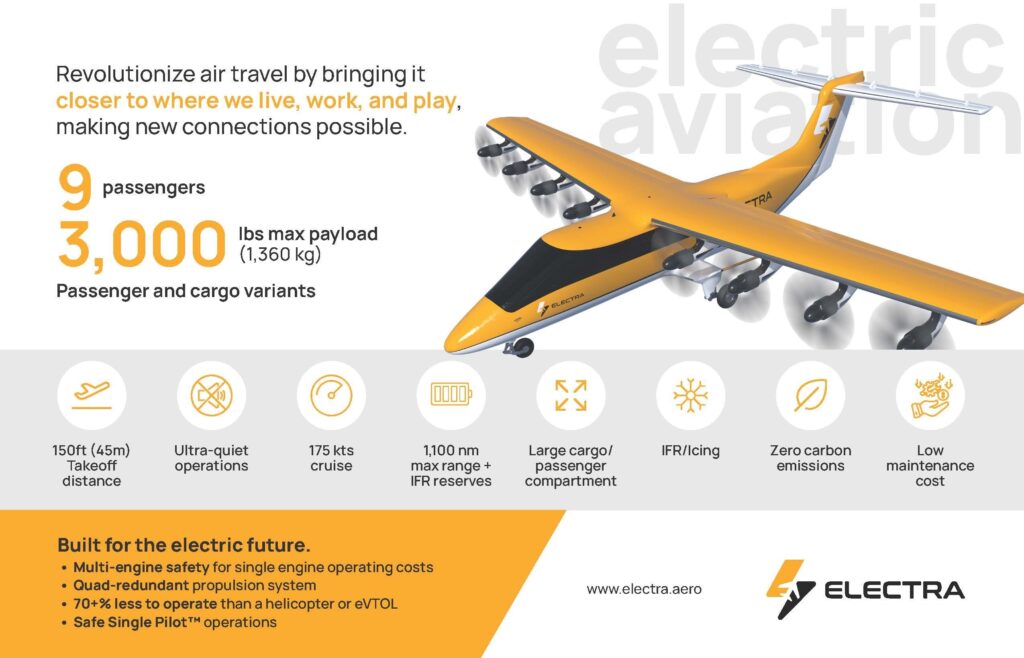
Electra EL9 Ultra-STOL (Ultra Short Takeoff and Landing aircraft)
- 9 passengers OR 3,000 lbs max payload
- 150 ft Takeoff distance
- 175 knots cruise
- 1,000 nautical mile range + IFR reserves
- hybrid-electric technology
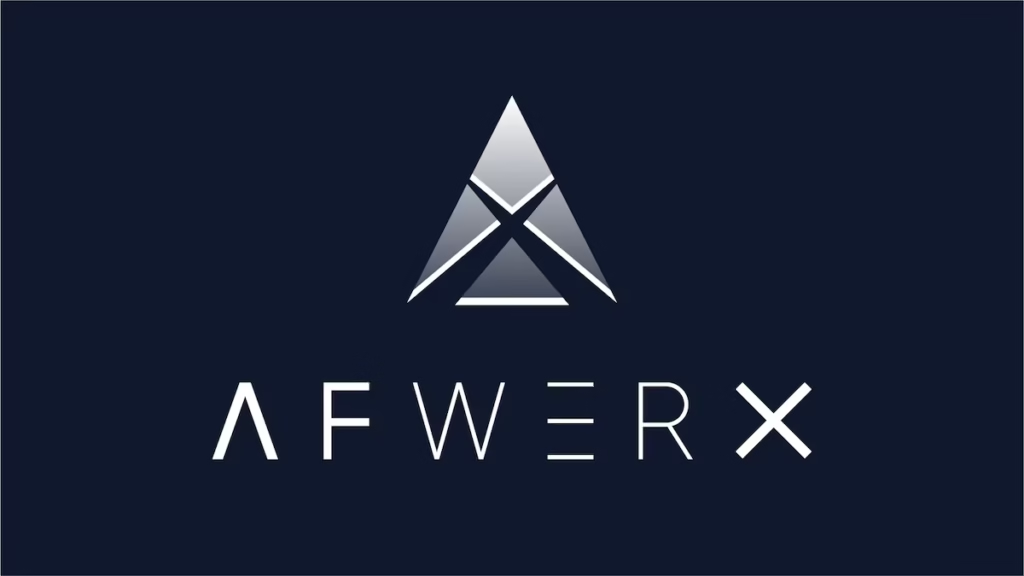
AFWERX
- Program of the Air Force Research Laboratory (AFRL)
- Innovation arm of the Dept of Air Force
- Connects innovators across government, industry and academia
- 1,8881 companies transitioned to Phase III ($7.5 B )
- 2,665 new companies included in small business portfolio of Department of Air Force (DAF)
- Headquarters in Dayton, Ohio
- 3 Hubs
- Austin, Texas
- Washington, DC
- Los Angeles, California

Col. Donn Yates (USAF Ret.)
- Vice President of Government Programs at Electra
- Graduated U.S. Air Force Fighter Weapons School, and became an instructor
- Led Joint Special Operations Aviation Detachment and the largest F-15E fighter wing in the US Air Force.
- Harvard Kennedy School National Security Fellow
“Working with our Air National Guard partners, the scenarios we executed are a concrete demonstration of how Ultra-STOL aircraft can augment existing platforms and fill an important gap in existing tactical airlift capabilities.” – Donn Yates, Electra’s Vice President of Government Programs
Future Flag: A Testbed for Tomorrow’s Air Force
The Future Flag initiative, spearheaded by AFRL and supported by various Air Force and Air National Guard units, is designed to accelerate the transition of emerging technologies into military use. Electra’s participation included collaborative flight operations with the 174th Attack Wing of the New York Air National Guard and other mission partners.
Backed by a Strategic Funding Increase (STRATFI) award through the U.S. Air Force’s AFWERX innovation arm, Electra’s technology underwent rigorous evaluation in simulated combat and logistical scenarios. These tests highlighted potential use cases such as medical evacuation, special operations support, mobile power generation, and autonomous supply drops.

174th Airlift Wing of the New York Air National Guard
- Based at Hancock Field (Syracuse Hancock International Airport) Onondaga County, New York
- Units:
- 152nd Air Operations Group
- 174th Operations Group
- 108th Attack Squadron (MQ-9 Reaper)
- 138th Attack Squadron (MQ-9 Reaper)
- 174th Operation Support Squadron
- 174th Maintenance Group
- 174th Mission Support Group
- 174th Security Forces Squadron
- 174th Medical Group
- MQ-9 Reaper
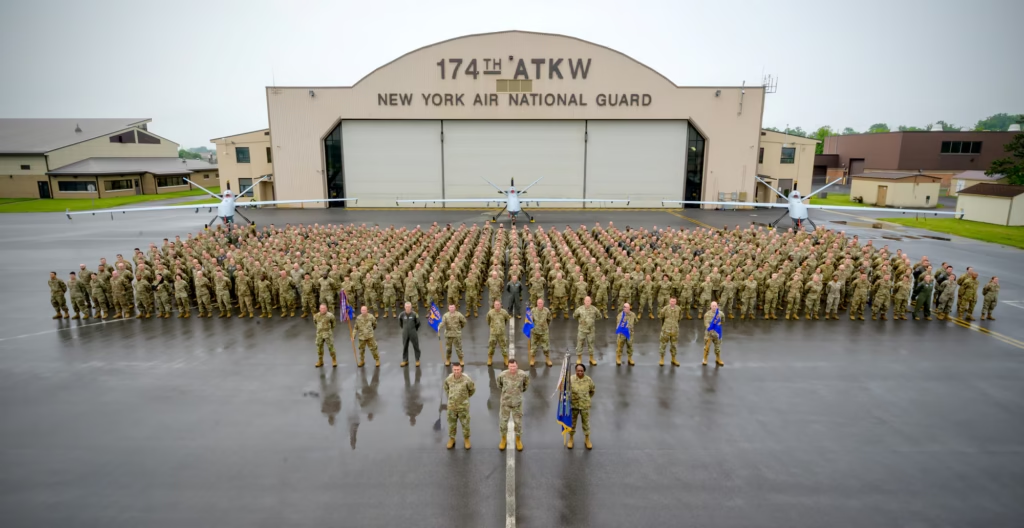

103rd Airlift Wing (103 AW) of the Connecticut Air National Guard
- Based in Bradley Air National Guard Base, Windsor Locks, Connecticut
- Units:
- 103rd Operations Group
- 118th Airlift Squadron
- 103rd Maintenance Group
- 103rd Mission Support Group
- 103rd Medical Group
- 103rd Air Operations Group
- Aircraft:
- C-130H Hercules
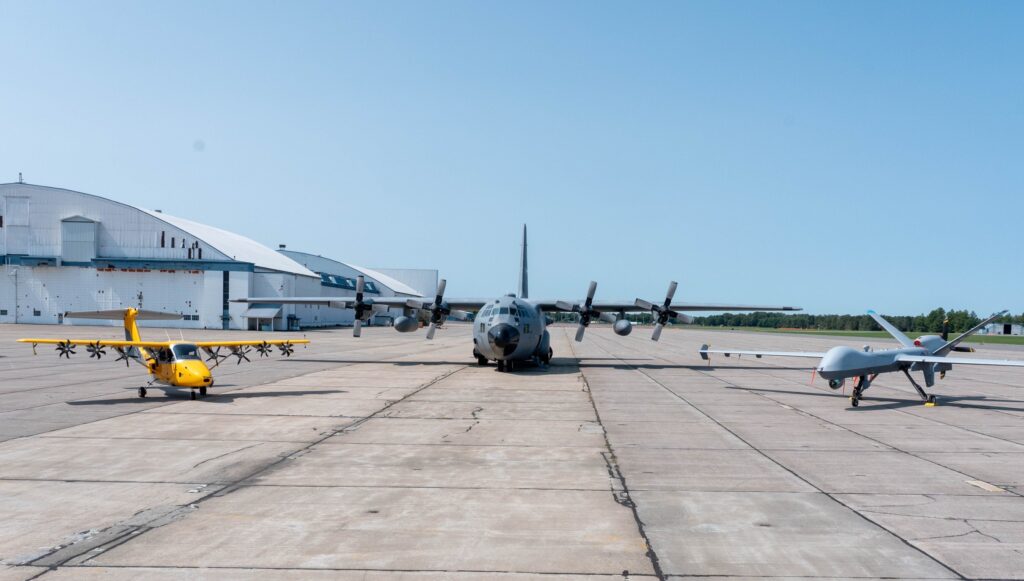

VP of Government Programs Donn Yates,
VP of Test, Validation, and Certification Buddy Sessoms, and
Director of Technology Development Chris Courtin, pictured with the Connecticut Air National Guard 103rd Air Wing and the New York Air National Guard 174th Attack Wing following participation in Air Force Research Lab’s Future Flag 25-3 Test Event in Rome, NY. (Credit: Senior Airman Emme Drummond)
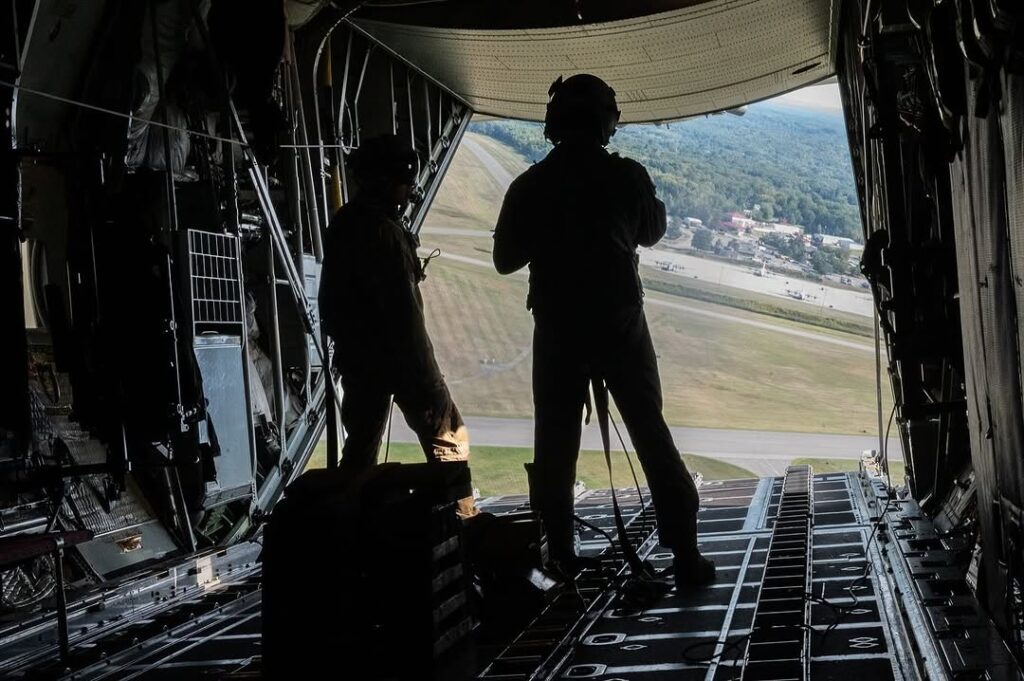


109th Airlift Wing (109 AW) of the New York Air National Guard
- Based in Stratton Air National Guard Base (Schenectady County Airport) in Scotia, New York
- Antarctic operations from:
- Christchurch International Airport, Christchurch, New Zealand
- Williams Field, Antarctica
- Major units:
- 109th Operations Group
- 139th Airlift Squadron 139th Aeromedical Evacuation Squadron
- 109th Maintenance Group
- 109th Mission Support Group
- 109th Medical Group
- Aircraft:
- C-130H Hercules
- LC-130H Hercules
Electra’s CEO, Marc Allen comments:

The CEO of Electra, Marc Allen wrote in a statement on LinkedIn:
“Keeping good company w/ our partner Lockheed Martin and big brother C130.”
– Marc Allen, CEO of Electra


Agility Prime (AFWERX)
- Founded in 2019
- Vertical lift and landing (VTOL) development program run by the Department of the Air Force in collaboration with the Army
- Provided small business partners more than 60 contracts totaling more than $390 million in the eVTOL and hybrid VTOL market
- 14 billion injected into private-sector commercial investment in the AAM industry
- In 2023, Electra was awarded up to $85 million in combined private, government, and SBIR matching funds via a Strategic Funding Increase (STRATFI) award
STRATFI: A Catalyst for Scale and Defense Partnership
Back in January 2023, Electra announced that it had been selected by AFWERX as a recipient of a STRATFI award, securing up to $85 million in combined private, government, and SBIR matching funds to develop a full‑scale pre‑production eSTOL aircraft.
Key points from that announcement include:
- The funding supports rapid test, evaluation, and prototype development for Electra’s next‑generation aircraft, accelerating the transition from technology demonstrators to viable, mission-capable platforms.
- Electra’s eSTOL concept is designed to operate from soccer field–sized footprints, combining the flexibility of rotorcraft with the efficiency and performance profile of fixed-wing aircraft.
- The award is firmly aligned with the U.S. Air Force’s interest in dual-use aviation solutions—those that serve both military and commercial missions.
- The STRATFI investment complements multiple existing SBIR / STTR contracts through which Electra has matured core subsystems: distributed electric propulsion, blown‑lift aerodynamics, flight controls, and hybrid power systems.
- The company sees its eSTOL architecture as a tool to support the Air Force’s Agile Combat Employment (ACE) doctrine—providing logistics, power export, and mobility assets to dispersed nodes in contested or austere environments.
In effect, the STRATFI award both validates Electra’s technology path and underwrites the resources needed to scale to a more operationally ready stage.
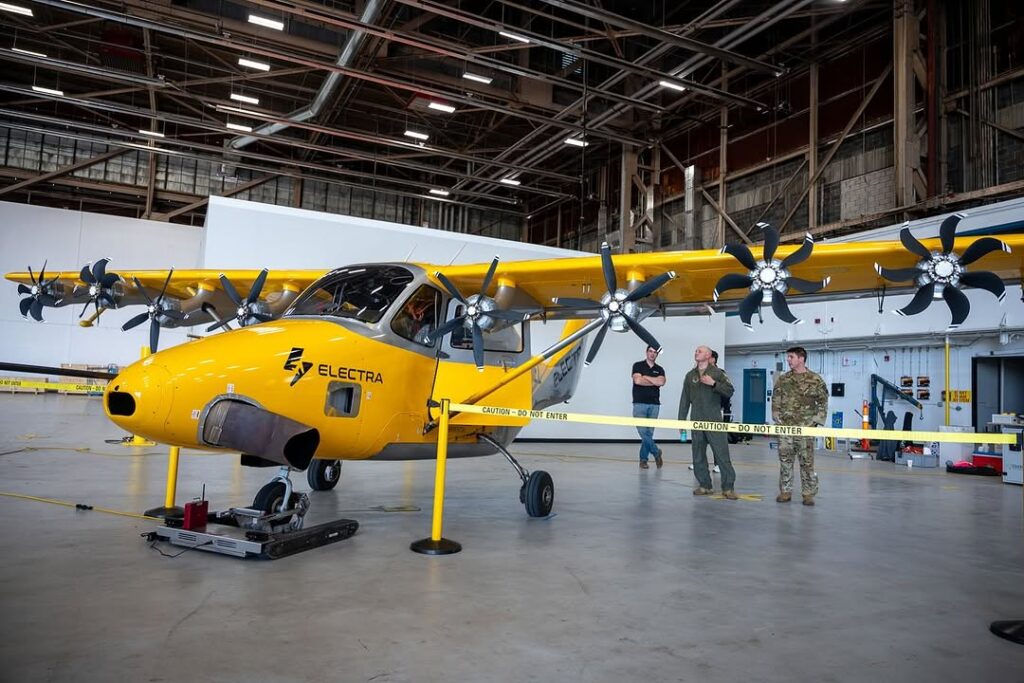
Future Flag 25‑3: Proof in the Sky
With the STRATFI foundation underpinning its development trajectory, Electra’s participation in Future Flag 25‑3 became not just a showcase, but a field test of progress.
- Electra deployed its EL2 demonstrator into government-structured missions—resupply, medical evacuation, and field power generation—alongside units such as the New York Air National Guard’s 174th Attack Wing.
- The demonstrator flights were designed to stress integration, interoperability, and mission relevance in austere, tactically realistic settings.
- The results from these flights feed directly into the development pathway enabled by STRATFI: data, lessons learned, and insights about systems robustness will guide refinement of the EL9 nine-passenger design and beyond.
Thus, Future Flag 25-3 served not just as a PR moment, but a real midpoint check of how Electra’s technologies are holding up under operational demand.

Strategic Implications & Market Positioning
By combining a major funding commitment with operational demonstration, Electra is positioning in a unique sweet spot. Some takeaways:
- Defense & dual-use alignment: The STRATFI award reflects the Air Force’s intent to invest in aviation capabilities that can pay dividends beyond strictly military missions. Electra’s pitch of efficient, flexible aircraft for humanitarian, logistics, and regional mobility aligns well with that paradigm.
- Bridging prototyping and deployment: Many aerospace ventures struggle to move beyond lab prototypes. The combination of STRATFI funding and Future Flag participation gives Electra legitimacy—and data—to justify the leap toward commercial and military deployment.
- Differentiation from eVTOL and rotorcraft: While eVTOL startups aggressively pitch “vertiports” and urban air mobility, Electra continues to leverage the advantage of short runways rather than vertical lift. Its claim: better payload, lower complexity, and a smoother regulatory path.
- Risk and expectations: Of course, the journey from test flights back-to-back to production, certification, and scale is nontrivial. But the STRATFI award, allied with real-world demonstration data, gives Electra some strategic runway (pun intended) that many peers lack.
What to Watch
- EL9 maturation: How quickly Electra can incorporate feedback from EL2 and Future Flag missions into the EL9 design, and prove its scalability will be critical.
- Regulatory and certification path: Securing FAA or equivalent certifications for hybrid-electric Ultra-STOL will be a major hurdle, especially given the novelty of the architecture.
- Adoption by defense and humanitarian partners: Demonstrating not just airworthiness but mission value (cost, throughput, reliability) to Pentagon stakeholders, NGOs, and even commercial logistics firms will be essential.
- Manufacturing and scaling: Even with funding, building supply chains, material sourcing, and production facilities for hybrid-electric aircraft are complex undertakings.
- Competitive response: As eVTOL, rotorcraft, and other short-takeoff concepts proliferate, Electra will need to continuously defend and improve its performance, cost, and operational value

Electra’s blending of funding and demonstration-driven progress illustrates a promising model for how aerospace startups can traverse the chasm from concept to relevance. If the fundamentals of their hybrid-electric Ultra-STOL design hold up under mission demand, the company may become a bellwether for how distributed, flexible aviation enters defense and commercial markets in tandem.
“It’s vital that we ensure new advanced air mobility technologies with dual-use applications are developed and manufactured here at home in the U.S.”….“Electra’s eSTOL technology has the potential to deliver valuable logistics and mobility capabilities to the Air Force. We value our partnership with Electra and look forward to supporting their continued development and future transition.” – Lieutenant Colonel John “Wasp” Tekell, Air Force Agility Prime Lead
Electra’s Strategic Edge
While much attention in the advanced air mobility (AAM) sector has gone to eVTOL and drone technologies, Electra is carving out a differentiated space with its fixed-wing Ultra-STOL architecture. Compared to rotorcraft and eVTOL solutions, Electra claims:
- 2–3× greater payload capacity
- 5–10× longer range
- Lower acquisition and operating costs
- Faster path to FAA certification
From a strategic standpoint, this positions Electra well for dual-use deployment across military, humanitarian, and regional commercial markets.
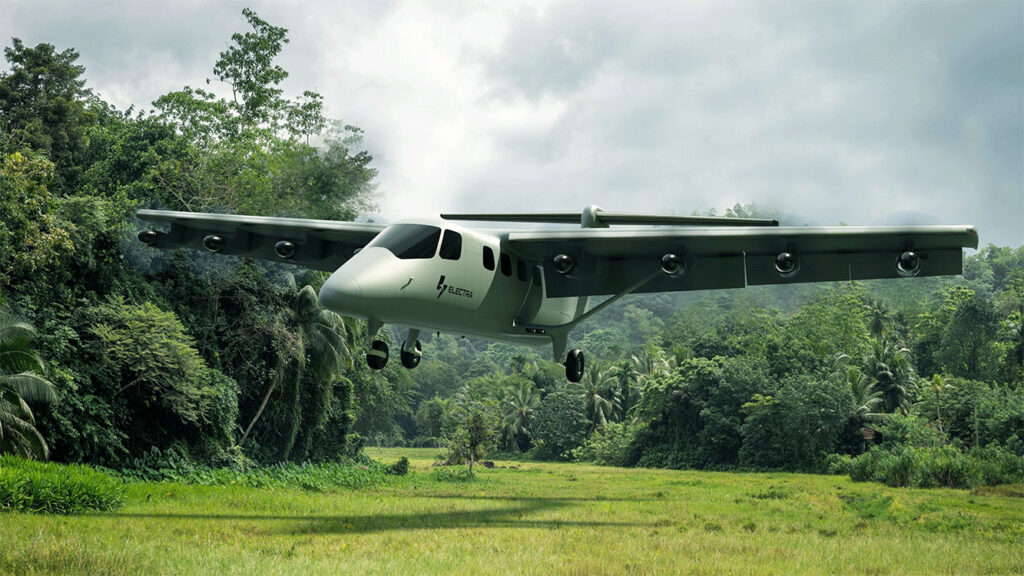
What’s Next?
With Future Flag 25‑3 now behind them, Electra’s focus turns to maturing the EL9 platform and scaling its manufacturing capabilities. The company continues to partner with defense agencies and civil aviation authorities to bridge the gap between test flights and operational deployment.
As defense and disaster response agencies face increasingly complex mobility challenges—from near-pear conflicts to climate-driven emergencies—solutions like Electra’s hybrid-electric Ultra-STOL aircraft offer a compelling mix of agility, endurance, and sustainability.
With many vertical flight concepts and battery-constrained all-electric airframes, Electra is making the case that short runways and hybrid-electric power may offer the most practical path forward.

More Info:
Electra Completes Participation in Air Force Research Lab’s Future Flag 25-3 Test Event: click here
U.S. Air Force Awards Electra Strategic Funding Partnership Valued up to $85M to Develop Full-Scale Pre-Production eSTOL Aircraft: click here
109th Airlift Wing (official website): click here
174th Attack Wing (official website): click here
CEO of Electra, Marc Allen’s post on Linkedin: click here
Electra Names Aviation Industry Veteran Donn Yates Vice President of Government Programs: click here
103rd Airlift Wing of the Connecticut Air National Guard: click here
f2fd38

